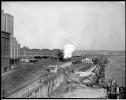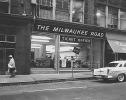
| Home | Open Account | Help | 350 users online |
|
Member Login
Discussion
Media SharingHostingLibrarySite Info |
Nostalgia & History > Depot Friday, SPUD and The Milwaukee RoadDate: 10/24/14 14:34 Depot Friday, SPUD and The Milwaukee Road Author: MartyBernard These photographs and captions are from the Minnesota Historical Society's Online Collection.
1. Looking east from the Robert Street bridge at a Milwaukee Road freight train behind double-headed steam locomotives passing the St. Paul Union Depot. Dates Creation: 01/17/1952 Notes: Forms part of Minneapolis and St. Paul Newspaper Negative Collection. ID Number: 104299 2. Railway Mail Service clerks load mail bags onto a Milwaukee Road Railway Post Office car at the St. Paul Union Depot. Dates Creation: 03/23/1949 ID Number: 103943 3. Milwaukee Road Ticket Office, 354 Cedar, St. Paul. Creation Photographer: St. Paul Dispatch & Pioneer Press Dates Creation: 1957 ID Number: 27489 Enjoy, Marty Bernard    Date: 10/24/14 15:16 Re: Depot Friday, SPUD and The Milwaukee Road Author: hogheaded A WOOD-sided RPO in 1949? Probably am wrong, but I thought that the Post Office banned wood-sided RPO's somewhere around WWI (wooden-framed, earlier), because of the threat of telescoping cars. Maybe the photo shows a former RPO used for storage mail?
-E.O. Date: 10/24/14 16:00 Re: Depot Friday, SPUD and The Milwaukee Road Author: LarryDoyle > 1. Looking east from the Robert Street bridge at a
> Milwaukee Road freight train behind double-headed > steam locomotives passing the St. Paul Union > Depot. Several times a day, double headed or triple headed Mikados (USRA heavy L-3 class or Milwaukee's own L-2 design) paused as seen here, sometimes with another Mikado pusher behind the caboose. When they got a clear signal they'd whistle off and take a run for the Short Line grade. They had about 4000', with a very slight downgrade dropping about 10 feet, then hit the diverging switches and reverse curves at Chestnut Street, and were immediately on the grade shown here http://www.trainorders.com/discussion/read.php?11,3557346 About as spectacular as steam can get! Four miles later, as they approached the summit at Snelling Avenue, the lead engine would cut off on the fly, run ahead, then back into the industrial lead at Macalester to let their train pass by without stopping. Enough action to make today's safety officers soil their drawers. In 1951, Baldwin promised a high horsepower, low speed solution to the Milwaukee's problem of moving freight from St. Paul to Minneapolis: AS-616 cow and calfs. Two pair, 2100A,B and 2101A,B, were expected to do the job. They didn't. They were soon split, the B units sent back to Eddystone and rebuilt into A units. This enabled Milwaukee to run them as a 3-unit set, with one left over for other chores. Apparently, three was the maximum MU capability of Baldwins pneumatic throttles. These four units were later renumbered 560-563. In 1953, four more AS-616's, 2104-2107, were ordered from Baldwin to double the capabilities of moving traffic between Minneapolis and St. Paul without steam. These eventually became 564-567. No other AS-616's were ever purchased. It is also interesting that Milwaukee specified that these machines would have the same (outmoded) carbody and trucks as their earlier engines, but they had electric governor control, making them incompatible with the older engines. Go figure. These 8 Baldwin diesel engines dominated the huge amount of traffic between Minneapolis and St. Paul for the next two decades. -John |